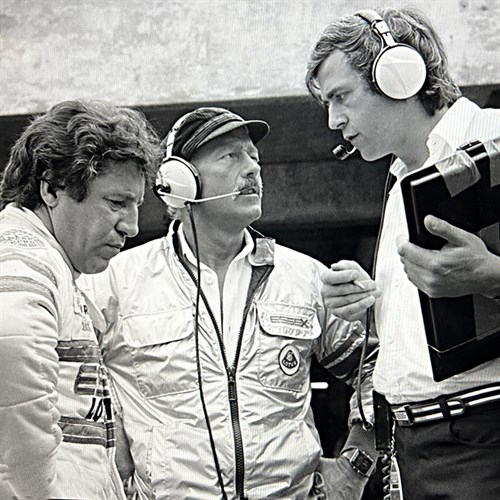With thanks to Andrew Stevens // Image: Wright with Chapman and Andretti via Classic Team Lotus
Peter Wright, the engineer who pioneered ground effect aerodynamics in motor racing, changing the face of Formula 1, has died aged 79. His pioneering work in the application of “ground effect” aerodynamics led to Team Lotus developing the Lotus 78 to win 5 Grand Prix in 1977, before refining the concept for 1978. Mario Andretti won the 1978 World Drivers Championship; Ronnie Peterson was 2nd, and Team Lotus took the constructors title, in a season dominated by the JPS liveried Lotus Type 79.
But Wright didn’t just change the face of Formula 1 with ground effect, he was also the first to fit a data recorder to an F1 car, and developed the first iteration of active suspension for Team Lotus. He took control of Team Lotus in the ’90s following Chapman’s death, before moving to the FIA where he arguably saved GT Sports Car Racing through application of Balance of Performance measures, and was instrumental in setting in motion many of the safety initiatives introduced into F1 including the HANS device and the halo.
His active suspension was initially used in the Lotus Type 92 during the 1983 season and then by Ayrton Senna in 1987 with the Lotus Type 99T, the first F1 car with active suspension to win a Grand Prix. It was also fitted to road cars, both as a technology demonstrator for Lotus, and for evaluation by various interested manufacturers.
Wright graduated in engineering from Cambridge, majoring in aerodynamics and thermodynamics. He joined BRM in 1966 where he was mentored by Tony Rudd. In 1969 he went to work for Specialised Mouldings where he designed a purpose-built wind tunnel that was later to become the Williams F1 team tunnel. He also designed the wing profile side-pods for the March 701, but they never developed the expected level of downforce.
Wright then joined Group Lotus subsidiary Technocraft, before rejoining Tony Rudd at Lotus in a new aerodynamic research and engineering base established by Colin Chapman. This engineering incubator was to look ahead for new directions in structures and aerodynamics.
Wright famously set up in the Imperial College rolling road wind tunnel and found that the underside of the car could produce huge downforce if the car’s side pods were sealed to the ground by sliding side skirts. His subsequent work on active suspension was stimulated by the need to stabilise the car to maximise the aerodynamics.
In the late ’80s Wright was Lotus engineering director, with responsibility for both Lotus products and customer cars. In 1990, he agreed to join Peter Collins in taking management control of Team Lotus as it struggled through its final years in F1.
Following the collapse of Team Lotus and Ayrton Senna’s death in 1994, he joined the FIA as Technical Advisor, applying his highly analytic approach to improving motor sport safety. He became the President of the FIA Safety Commission, and undoubtedly saved lives through the application of structured engineering and scientific principles to race car and track safety.
Some of the safety improvements under his watch included Head and Neck Restraint System (HANS), the basis for the halo, the cockpit survival cell, and wheel tethers. He also was instrumental in the revised technical regulations, the drag reduction system, and the introduction of hybrid power units into F1.
At the end of 2004, GT sportscar racing was facing an existential crisis with the advent of manufacturer homologation of purpose built race cars, first with the Porsche GT1, and then the Maserati MC12. Wright proposed to balance the performance of the cars competing using a simulation based methodology. This was embraced by the sportscar organising body, and the competitors, and Wright architected the approach that is used to this day in GT3 and LeMans sports cars across the globe. Following benchmark testing with the MC12 and Ferrari 550, he ran the initial balancing exercise, restricting the Maserati’s advantages, and allowing four different manufacturers to win races in a highly competitive 2005 season.
For all that, it is undoubtedly his work in pioneering ground effect aerodynamics that led to the beautiful and dominant JPS Lotus Type 79 that will remain his most memorable legacy.

